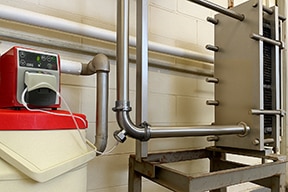Inline Sampling on Dairy Farms

Milk quality starts on the farm. For today’s progressive dairy operations, producing high-quality milk is essential for both profitability and animal health. Inline sampling gives producers a proactive, reliable tool to monitor milk quality and manage herd health more effectively.
The High Cost of Contamination
Contamination on dairy farms is a multifaceted challenge that impacts profitability, milk safety, and quality. It includes intramammary infections like mastitis, elevated somatic cell counts (SCC), and spoilage-causing contaminants such as coliforms and psychrotrophic bacteria that can survive cold storage and impact product quality well down the supply chain.
Mastitis alone costs the U.S. dairy industry over $2 billion annually. Elevated SCC often signals an immune response and infection in the udder. Meanwhile, coliforms from poor hygiene or environmental exposure, and spoilage organisms hiding in equipment crevices, may go undetected without continuous monitoring.
Bulk tank SCC averages clearly correlate with profitability: farms with SCC below 150,000 cells/mL consistently outperform those above 250,000. For targeting premium payments and long-term quality assurance, contamination must be understood as a system-wide risk that requires system-wide visibility.
Locating Milk System Contamination
Bulk tank testing provides a snapshot that can identify a problem but rarely its source. Contamination may stem from a single cow, a hygiene failure, or a hidden biofilm in a valve or balance tank. Without targeted sampling, it’s nearly impossible to know.
By installing aseptic sample collection points at key locations in the milk flow path, inline sampling gives producers the ability to:
- Monitor specific groups of cows during milking
- Validate hygiene and sanitation practices
- Track SCC trends to catch infections early
- Identify whether a specific piece of equipment is introducing contaminants
By sampling milk at different stages of the milking and transfer process, farms can isolate the source of quality issues and take corrective action quickly.
Better Sampling, Better Decisions
Accurate, aseptic sampling is essential to effective quality control. Traditional grab samples risk introducing contamination, especially when taken from dippers, non-sterile ports, or open lines. They also may not be representative of the milk flow, increasing the risk of false results, missed pathogens, discarded milk, or undiagnosed infections.
QualiTru’s sampling system enables farms to obtain reliable, representative samples without exposing the milk to external contaminants. Using TruStream ports, sterile TruStream septa, and collection bags, dairy producers can confidently monitor milk quality over time and across locations—helping them make better decisions with better data.
Real-Farm Results: Inline Sampling for Dairy Farm Hygiene and Herd Health
Inline sampling isn’t just theoretical. At a university dairy in Georgia, it was used to trace aerobic bacteria and Mycoplasma back to specific points in the milking system, identifying persistent sources of mastitis contamination. By strategically sampling at key points—including before and after the plate cooler—researchers were able to pinpoint persistent contamination caused by ineffective cleaning and internal biofilms. The study demonstrated how inline aseptic sampling offers a reliable, real-time method for identifying microbial hotspots, improving cleaning protocols, and enhancing overall milk quality monitoring. (Source: Veterinary Medicine and Science, 2021)
With practical tools and real-time insights, inline sampling helps farms reduce losses, improve herd health, and maintain consistent milk quality.
Detecting Biofilm Contamination in Dairy Equipment
Spoilage bacteria and mastitis pathogens thrive in biofilms—resilient bacterial colonies that form on the interior surfaces of milking equipment. These structures are difficult to detect and even more difficult to eliminate with standard cleaning methods. As they shed bacteria into the milk, biofilms can cause persistent quality issues even in well-managed herds.
Routine inline sampling is a reliable method for identifying active biofilms in process lines. By sampling before and after critical points like valves, plate coolers, or balance tanks, producers can detect and isolate these contamination sources before they spread.
QualiTru’s aseptic sampling solutions provide a simple, fast, and reliable method for inline milk sampling on dairy farms. Engineered for seamless integration with milking systems, these pre-sterilized, ready-to-use systems enable accurate monitoring of milk quality at critical points in the milk flow path. By supporting proactive mastitis detection, bacterial count tracking, and contamination source isolation, QualiTru’s inline sampling tools help dairy producers safeguard herd health, reduce milk losses, and maintain consistent product quality.
- Inline Sampling
- TruStream7 Tri-Clamp Tee 2” (Part #215147) or TruStream 7 Tri-Clamp Elbow 2″ (Part #213029)
- TruStream7 Septum (Part # 110011)
- TruStream 250ml/18g (Part #111450) or TruMotion 2L/18g w/2.0mm Tubing (Part #111770) with a Watson-Marlow Pump (Part #500000) for a representative sample or the TruDraw® Sterile Single Sampler (Part #112021) for a small, aseptic sample
Improve Milk Quality Monitoring with Inline Sampling
No matter the size of your dairy operation, inline sampling offers a smarter, more precise way to monitor milk quality, detect mastitis-causing pathogens early, and stop contamination at the source. Talk to a QualiTru expert today to learn how inline sampling can help you protect your milk, your herd, and your bottom line.



